#schinus molle
Explore tagged Tumblr posts
Text

10 notes
·
View notes
Text

Faux poivrier (Schinus molle)
5 notes
·
View notes
Text
offerings from the day of love, day of ashes
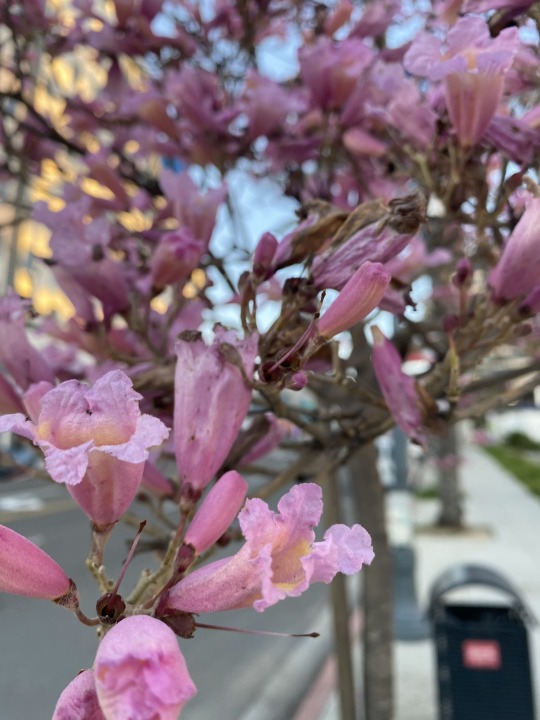





#another valentine’s day/ash wednesday mashup#foxy back in the land of seussian flora#and sunnier skies#no idea what that beautiful pink flowering tree is#bird of paradise#pretty purple flowers#gobsmackingly interesting succulents#california pepper tree#schinus molle#“a shade tree with pretty somewhat pendulous branches and an attractive exfoliating trunk” - fab description!#happy valentine’s day#blessed ash wednesday#personal#beautiful flora#foxy takes pics#and shows her forehead#thought i might be giving up reading fic on my tablet for lent#but HOORAY it’s not lost i only left it behind in security
4 notes
·
View notes
Text



S – Schinus molle L. – Pepe falso (Anacardiaceae)
21 notes
·
View notes
Text


Found a big colony of polypore mushrooms on a Peruvian peppertree (schinus molle). Maybe some kind of ganoderma? It looks like one!
it's hard to say what species, though. Mushrooms are tricky enough, and polypores are even trickier for me. If it's not something good like sulfur shelf, hedgehog, or oxtongue, then it's not really worth disturbing, in my opinion!
The peppertree looked like it was doing alright, so I guess the relationship is probably parasitic. The fruiting bodies themselves were quite large and wrapped around the entire base of the trunk, so they're probably pretty well-established. Makes you wonder how long the peppertree has left!
3 notes
·
View notes
Text

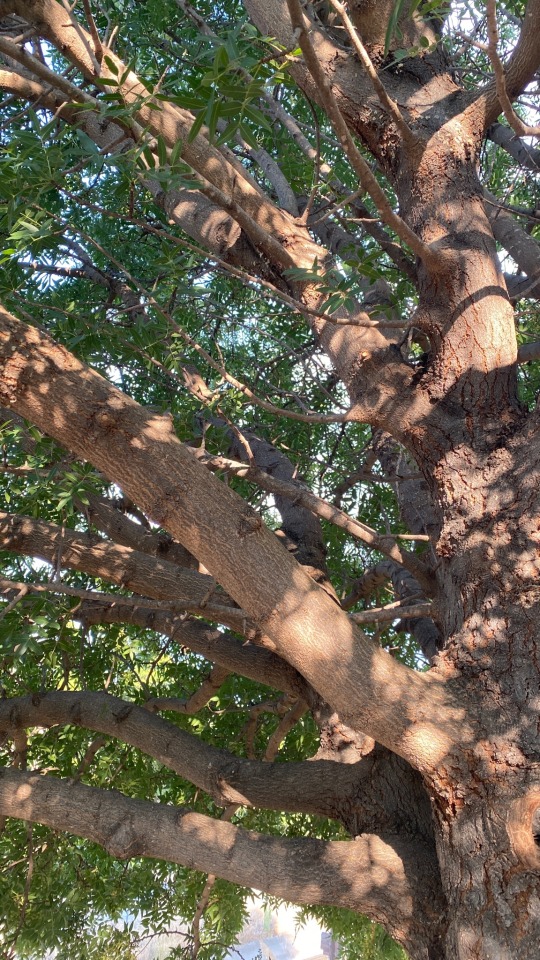


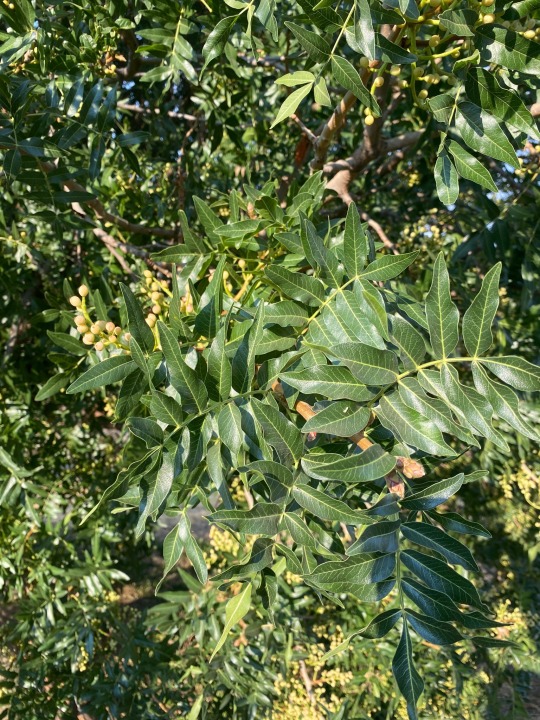
California Peppertree
Schinus molle (Peruvian pepper, also known as American pepper, Peruvian peppertree, escobilla, false pepper, rosé pepper, molle del Peru, pepper tree, peppercorn tree, California pepper tree, pirul, Peruvian mastic, Anacahuita o Aguaribay and Pepperina)
Sprouted 15 years ago (2008) in our yard. 30 feet in diameter now. Never been pruned (I’ve totally ignored it - no water or fertilizer either).
I’m going to be pruning it today. Cutting out conflicting branches, dead wood, suckers, and lower branches.
2 notes
·
View notes
Text
Molle KB1496
Molle KB1496. Schinus Molle. Maceta: Entrenamiento. Sustrato: Akadama 100%. Alto: 16 cm. Ancho: 30 cm. Tronco: 4 cm. Cultivo propio.

View On WordPress
2 notes
·
View notes
Text
Różowy pieprz to owoc drzewa z gatunku Schinus molle (pieprzowiec peruwiański) lub Schinus terebinthifolia (pieprzowiec brazylijski), a nie prawdziwy pieprz, który pochodzi z rodziny pieprzowatych (Piperaceae). Choć nazywany "pieprzem", różowy pieprz nie jest bezpośrednio spokrewniony z czarnym, białym czy zielonym pieprzem, lecz pochodzi z rodziny nanerczowatych (Anacardiaceae). Ma łagodniejszy, owocowy smak, lekko pikantny z nutami cytrusowymi i żywicznymi dzięki czemu jest ceniony zarówno w kuchni jak i w aromaterapii.

Gdzie rośnie?
Różowy pieprz pochodzi z Ameryki Południowej, a jego naturalny zasięg obejmuje głównie:
Peru – Pieprzowiec peruwiański (Schinus molle) jest tam szeroko rozpowszechniony i ceniony od czasów prekolumbijskich.
Brazylia – Pieprzowiec brazylijski (Schinus terebinthifolia) jest rodzimy dla regionów południowo-wschodniej Brazylii.
Obecnie drzewa te rosną również w innych rejonach o ciepłym, tropikalnym klimacie takich jak:
Kalifornia i Floryda w Stanach Zjednoczonych,
Australia i Afryka (np. w Afryce Południowej),
Kraje basenu Morza Śródziemnego.
Drzewa różowego pieprzu są wytrzymałe i rosną na obszarach suchych często występując na terenach gdzie inne rośliny mają trudności z przetrwaniem. Owoce różowego pieprzu są małe o intensywnie różowym kolorze, a ich smak jest unikalnym połączeniem słodyczy i ostrości.
Wykorzystanie:
Kulinaria: Różowy pieprz jest używany jako przyprawa w kuchniach na całym świecie zarówno do dań mięsnych, rybnych, jak i deserów.
Aromaterapia: Olejek eteryczny z różowego pieprzu jest ceniony za swoje właściwości antybakteryjne, antyseptyczne i pobudzające.
Tradycyjna medycyna: W Ameryce Południowej różowy pieprz był używany w celach leczniczych do wspomagania trawienia i leczenia infekcji.
Różowy pieprz w aromaterapii
Różowy pieprz znajduje zastosowanie w aromaterapii gdzie wykorzystuje si�� jego olejek eteryczny pozyskiwany z owoców drzewa pieprzowca. Olejek doTerra charakteryzuje się ciepłym, pikantnym, lekko słodkawym aromatem z nutami cytrusowymi. W aromaterapii różowy pieprz jest ceniony za swoje działanie pobudzające, wspomagające koncentrację i poprawiające nastrój. Ma również właściwości wspierające układ odpornościowy i oddechowy.
Właściwości olejku z różowego pieprzu w aromaterapii:
Pobudzanie umysłu i koncentracji: Olejek z różowego pieprzu jest znany z właściwości stymulujących umysł i poprawiających zdolność koncentracji. Może być pomocny podczas nauki lub pracy wymagającej skupienia. Inhalacja jego aromatu pomaga w poprawie jasności umysłu i pobudzeniu do działania.
Redukcja stresu i napięcia: Chociaż olejek z różowego pieprzu pobudza ma także właściwości równoważące, które mogą pomóc w łagodzeniu stresu, lęku i napięcia emocjonalnego. Wdychanie jego zapachu wspiera relaksację i przywraca spokój.
Wspomaganie układu oddechowego: Olejek z różowego pieprzu może być stosowany w mieszankach aromaterapeutycznych w celu łagodzenia objawów przeziębienia, kaszlu oraz problemów z oddychaniem. Jego właściwości antybakteryjne i rozgrzewające pomagają oczyścić drogi oddechowe.
Wspomaganie trawienia: Wdychanie olejku z różowego pieprzu może również korzystnie wpływać na trawienie. Może pomóc złagodzić dolegliwości takie jak wzdęcia, niestrawność czy skurcze brzucha.
Wspieranie układu odpornościowego: Dzięki właściwościom przeciwbakteryjnym i przeciwgrzybiczym olejek z różowego pieprzu może być używany w mieszankach, które wspierają układ odpornościowy i chronią przed infekcjami.
Pobudzanie krążenia: Olejek z różowego pieprzu stosowany w masażach, pomaga poprawić krążenie krwi co jest korzystne dla osób z zimnymi dłońmi i stopami, a także może przyczyniać się do zmniejszenia napięcia mięśniowego.
Jak stosować olejek z różowego pieprzu doTerra Pink Pepper w aromaterapii?
Dyfuzor: Dodaj kilka kropel olejku do dyfuzora, aby odświeżyć i pobudzić umysł. Jego pikantny zapach doskonale nadaje się do stosowania w biurze lub podczas nauki.
Inhalacje: Wdychaj bezpośrednio z butelki lub aplikuj na chusteczkę, aby zredukować stres i poprawić nastrój.
Masaż: Rozcieńcz olejek z różowego pieprzu w oleju bazowym i wykonaj masaż, aby poprawić krążenie i rozluźnić mięśnie.
Kąpiel aromaterapeutyczna: Dodaj 3-5 kropli do ciepłej kąpieli, aby rozgrzać ciało, zrelaksować się i zredukować napięcie.
Olejek eteryczny z różowego pieprzu to wszechstronny produkt w aromaterapii, który łączy w sobie właściwości pobudzające i relaksacyjne. Pomaga w poprawie koncentracji, łagodzeniu stresu, wspomaganiu układu oddechowego i trawiennego, a także poprawia krążenie krwi. Dzięki swojemu charakterystycznemu, pikantnemu aromatowi, jest chętnie stosowany w mieszankach olejków eterycznych zarówno w celach terapeutycznych jak i kosmetycznych.

#RóżowyPieprz#Aromaterapia#OlejekEteryczny#Relaksacja#Antystres#Uspokajający#PodnosiNasrój#Oczyszczanie#Energia#Stymulacja#PoprawaNastroju#Odporność#PielęgnacjaSkóry#NaturalnaPielęgnacja#WzmacniaKreatywność#Detoksykacja#OlejkiEteryczne#ZdrowyStylŻycia#HolistycznePodejście
0 notes
Text
Lista de 100 Espécies de Árvores Nativas Brasileiras para Reflorestamento
rientações sobre Plantio e Adubação para um Crescimento Saudável

Segue uma lista de 100 espécies de árvores nativas do Brasil, adequadas para projetos de reflorestamento, juntamente com orientações detalhadas sobre como plantar e adubar para garantir um crescimento saudável.
*Contato:
-Telefone: [Paulo ]
- E-mail: [[email protected]]
- Endereço:[Limeira/SP]
Lista de Mudas de Árvores Nativas e Urbanas para Reflorestamento
Ipê Amarelo (Handroanthus albus)
Araucária (Araucaria angustifolia)
Jequitibá-Rosa (Cariniana legalis)
Pau-Brasil (Paubrasilia echinata)
Pitangueira (Eugenia uniflora)
Jabuticabeira (Plinia cauliflora)
Aroeira (Schinus terebinthifolia)
Embaúba (Cecropia pachystachya)
Sibipiruna (Caesalpinia peltophoroides)
Pata-de-Vaca (Bauhinia forficata)
Como Plantar e Adubar
Preparação do Solo
Escolha do Local: Selecione um local que receba luz solar adequada e que tenha espaço suficiente para o crescimento da árvore.
Preparo do Solo: Faça uma cova de aproximadamente 60x60x60 cm. Misture o solo retirado com adubo orgânico (composto ou esterco bem curtido).
Plantio
Retire a Muda do Saco Plástico: Com cuidado, retire a muda do saco plástico ou do recipiente em que veio, preservando o torrão de terra ao redor das raízes.
Posicione a Muda na Cova: Coloque a muda na cova de forma que o colo (junção entre o caule e as raízes) fique nivelado com a superfície do solo.
Preencha a Cova: Complete a cova com a mistura de solo e adubo, pressionando levemente para eliminar bolsas de ar.
Adubação
Adubação de Plantio: Utilize cerca de 10-20 litros de esterco bem curtido ou composto orgânico por cova, misturando bem com o solo.
Adubação de Manutenção: A cada seis meses, aplique uma adubação de cobertura com matéria orgânica (esterco curtido ou composto) ou com adubo químico, de acordo com a necessidade específica da espécie.
Cuidados Pós-Plantio
Rega: Regue a muda imediatamente após o plantio e mantenha o solo úmido, principalmente nos primeiros meses. Em regiões secas, regue 2 a 3 vezes por semana.
Proteção: Proteja a muda contra ventos fortes e animais, utilizando estacas ou cercas de proteção.
Podas: Realize podas de formação e limpeza, removendo ramos secos, doentes ou mal posicionados.
Dicas Gerais para Crescimento Saudável
Mulching: Aplique uma camada de mulch (palha, folhas secas) ao redor da base da árvore para manter a umidade do solo e controlar ervas daninhas.
Controle de Pragas e Doenças: Inspecione regularmente as árvores e trate prontamente qualquer infestação ou doença.
Acompanhamento: Acompanhe o desenvolvimento das árvores e ajuste as práticas de manejo conforme necessário para garantir um crescimento saudável.
Essas orientações básicas ajudarão a garantir que suas mudas de árvores nativas e urbanas cresçam saudáveis e contribuam efetivamente para o reflorestamento e a arborização urbana.
Angico Branco (Anadenanthera colubrina)
Angico Vermelho (Parapiptadenia rigida)
Aroeira Pimenteira (Schinus molle)
Aroeira Salsa (Schinus terebinthifolius)
Aroeira-do-Sertão (Myracrodruon urundeuva)
Araribá (Centrolobium tomentosum)
Araucária (Araucaria angustifolia)
Bacupari (Garcinia gardneriana)
Balsa (Ochroma pyramidale)
Baru (Dipteryx alata)
Biru (Nectandra megapotamica)
Cagaita (Eugenia dysenterica)
Caliandra (Calliandra dysantha)
Camboatá (Cupania vernalis)
Cambuci (Campomanesia phaea)
Canela (Ocotea pulchella)
Canela Amarela (Nectandra lanceolata)
Canela de Ema (Vochysia bifalcata)
Canela Sassafrás (Ocotea odorifera)
Canjerana (Cabralea canjerana)
Capixingui (Croton floribundus)
Caroba (Jacaranda macrantha)
Caroba da Mata (Jacaranda caroba)
Carobinha (Jacaranda puberula)
Cássia-rosa (Cassia grandis)
Cedro Rosa (Cedrela fissilis)
Cerejeira do Rio Grande (Eugenia involucrata)
Copaíba (Copaifera langsdorffii)
Embaúba (Cecropia pachystachya)
Figueira (Ficus insipida)
Garapa (Apuleia leiocarpa)
Goiabeira (Psidium guajava)
Grumixama (Eugenia brasiliensis)
Guabiroba (Campomanesia xanthocarpa)
Guapuruvu (Schizolobium parahyba)
Imbuia (Ocotea porosa)
Ipê Amarelo (Handroanthus albus)
Ipê Branco (Tabebuia roseoalba)
Ipê Rosa (Handroanthus impetiginosus)
Ipê Roxo (Handroanthus heptaphyllus)
Jacarandá Bico-de-pato (Machaerium villosum)
Jacarandá Mimoso (Jacaranda mimosifolia)
Jequitibá Branco (Cariniana estrellensis)
Jequitibá Rosa (Cariniana legalis)
Jabuticabeira (Plinia cauliflora)
Jatobá (Hymenaea courbaril)
Louro Pardo (Cordia trichotoma)
Manacá da Serra (Tibouchina mutabilis)
Manduvi (Sterculia striata)
Mogno Brasileiro (Swietenia macrophylla)
Monjoleiro (Acacia polyphylla)
Murici (Byrsonima crassifolia)
Oiti (Licania tomentosa)
Olho-de-Cabra (Ormosia arborea)
Palmeira Juçara (Euterpe edulis)
Palmeira Real (Archontophoenix cunninghamiana)
Pau-Brasil (Paubrasilia echinata)
Pau Ferro (Caesalpinia ferrea)
Pau Formiga (Triplaris americana)
Pau Jangada (Riedelia sp.)
Pau Mulato (Calycophyllum spruceanum)
Pau Preto (Nectandra oppositifolia)
Pitangueira (Eugenia uniflora)
Pindaíba (Xylopia brasiliensis)
Piquiá (Caryocar villosum)
Pitomba (Talisia esculenta)
Piqui (Caryocar brasiliense)
Pitangueira (Eugenia uniflora)
Pitangueira-da-Mata (Eugenia blastantha)
Quaresmeira (Tibouchina granulosa)
Sapucaia (Lecythis pisonis)
Sibipiruna (Caesalpinia peltophoroides)
Sucupira (Bowdichia virgilioides)
Tarumã (Vitex montevidensis)
Timburi (Enterolobium contortisiliquum)
Tingui (Magonia pubescens)
Ubaia (Eugenia patrisii)
Umbu (Spondias tuberosa)
Uvaia (Eugenia pyriformis)
Uva-do-Japão (Hovenia dulcis)
Vinhático (Plathymenia reticulata)
Ypê-amarelo-do-cerrado (Tabebuia ochracea)
Ypê-branco (Tabebuia roseoalba)
Ypê-roxo (Tabebuia heptaphylla)
Ypê-tabaco (Handroanthus serratifolius)
Zabumba (Parkia multijuga)
Zezinho (Pterogyne nitens)
Ingá (Inga edulis)
Pau-formiga (Triplaris americana)
Pau-de-óleo (Copaifera langsdorffii)
Pau-Jacaré (Piptadenia gonoacantha)
Pau-Rosa (Aniba rosaeodora)
Pereiro (Aspidosperma pyrifolium)
Pequi (Caryocar brasiliense)
Peroba-rosa (Aspidosperma polyneuron)
Pimenta-de-macaco (Xylopia aromatica)
Pitomba (Talisia esculenta)
Quaresmeira-roxa (Tibouchina granulosa)
Roxinho (Peltogyne confertiflora)
Sucupira-branca (Pterodon emarginatus)
Plantio e Adubação para Crescimento Saudável
Plantio
Escolha o Local: Local ensolarado, espaçamento adequado (mínimo de 3-4 metros entre as mudas).
Preparo da Cova: 60x60x60 cm. Misture o solo com adubo orgânico (esterco ou composto).
Plantio da Muda: Coloque a muda no centro da cova e complete com a mistura de solo e adubo. Pressione levemente ao redor da muda para fixar bem.
Adubação
Adubação Inicial: Misture 10-20 litros de esterco bem curtido ou composto orgânico no solo de plantio.
Adubação de Manutenção: Semestralmente, aplique adubo orgânico ao redor da árvore, sem tocar o tronco. Utilize esterco bem curtido ou composto.
Cuidados Pós-Plantio
Rega: Rega regular, especialmente nos primeiros meses. Manter o solo úmido, mas não encharcado.
Proteção: Proteger a muda de ventos fortes e animais.
Podas: Realize podas de formação e limpeza para remover ramos secos ou doentes.
Seguindo essas orientações, você poderá garantir o crescimento saudável das árvores e contribuir de forma significativa para o reflorestamento.






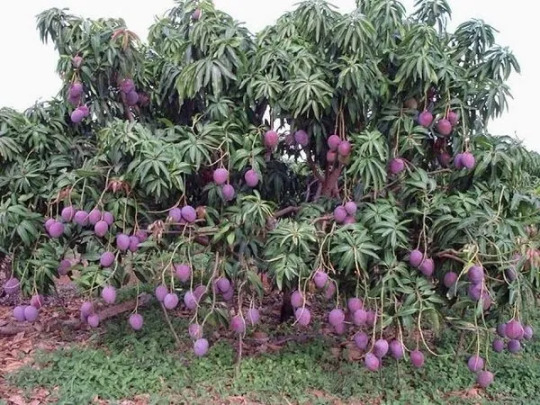

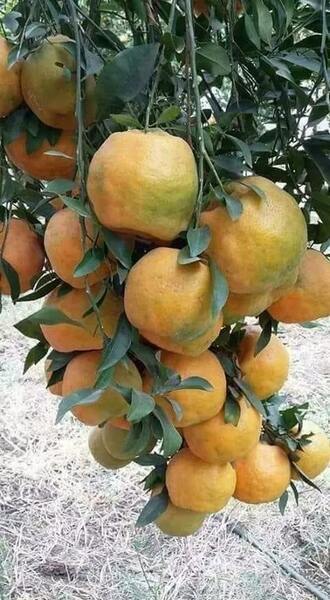
#https://jardimbr.blogspot.com/2024/07/protetor de caule para plantas e mudas.html#MudasFrutíferas#MudasDeFrutas#Pomar#Fruticultura#MudasDeLaranja#MudasDeMaçã#MudasDePêssego#MudasDeCoco#MudasDeJabuticaba#MudasDeAmora#MudasDeGoiaba#MudasDeCajá#MudasDeAcerola#MudasDeLichia#MudasDeFigo#MudasDeGuabiroba#MudasDePitaya#MudasDeNêspera#MudasDePinha#MudasDeAbacate#MudasDeUvaia#MudasDePitanga#MudasDeAtemoia#CultivoDeFrutas#FrutasFrescas#Jardinagem#JardimFrutífero#PlantasFrutíferas#CultivoDePlantas
1 note
·
View note
Text
Say "Teotihuacan" 10x fast
For many reasons it's important to preserve, honor and acknowledge the original stewards of existing lands. Admittedly, I struggled with new syllables and practiced several times [TEO-TI-WA'KAN], [TEO-TI-WA'KAN], [TEO-TI-WA'KAN]. Now, here's what no one struggles with...feeling in AWE! Like jaw dropping, ancient, archeological type awe.
According to Wikipedia (I know), "Teotihuacan is known today as the site of many architecturally significant Mesoamerican pyramids, namely the Pyramid of the Sun and the Pyramid of the Moon. It is considered as the first advanced civilization on the North American continent, with a population estimated at 125,000, making it at least the sixth-largest city in the world during its epoch."

"The city covered 8 square miles and up to 90 percent of the total population of the valley resided there. Teotihuacan is thought to have been established around 100 BCE (Before Common Era), and may have lasted until the 8th century CE, but its major monuments were systematically burned around 550 CE."
If visiting, here are my Gitanavida Pro tips:
Watch out for the Jaguar whistle. Sounds wayyy too real.
Watch out for those steps. Wayyy too steep.
Watch out for that sun. Wayyy too hot. Water, sunblock and hats are a must.
Photo buddy optional but handy. Shout out to my Bolivian homie!
Mezcal tour…wayyy worth it.




While visiting, I also noticed a tree that was all around. Turns out it's the infamous tree, as in the famous song (clip below), "Lena de Pirul". I then learned that "Pirúl (Schinus molle) is also known as Árbol Del Perú, Peruvian Peppertree, and in Nahuatl, it is Pelonquáhuitl and is native to the Peruvian Andes. The indigenous put a high value on the pirúl because of its many uses."
#teotihuacan #mexico #travels #history #explore
0 notes
Text
Bromeliad Society of New Zealand journal -
Jan 1986 issue
featuring the garden of my maternal Grandma and Grandpa, Hazel and John Jack

Post- it note:
Hi Diane,
enclosed is an article on your Mum & Dad's garden in 1985
Kind regards,
Dave A

Visit to Mr and Mrs Jack.
WM. Rogers.
Our last society visit for 1985 was to Jacks' on the North Shore. About 30 members attended a pleasant mild early Summer afternoon. The front garden is very simple, a series of curves - a curved lawn, a curved pebble garden planted with two or three low growing, wide spreading junipers and a clump of Drosanthemum against a setting of red paving and red pebbles.
On one side of the house is a narrow border of low growing ferns. The back of the house is at the top of a steep incline, almost a cliff, looking out over the motorway and an inlet of the Waitemata harbouor. This steep incline is laid out largely as a bromeliad garden. Paths and stairways zig-zag downwards through pebble covered beds and slopes and scoria retaining walls. The garden slopes downwards to the east, getting the morning sun. It has been planted with a number of tall shrubs such as Schinus molle which give dappled light to the plants beneath. Some of the shrubs which might have cast too much shade have had their foliage thinned somewhat. The garden is virtually frost free.
The top terrace below the house contains a variety of well spaced speciment plants set out widely to display their individual shapes and colours.
On the next terrace is small greenhouse packed with miniature tillandsias, dwarf orchids and a number of offsets being propagated. Some wire baskets contained clusters of dry loving tillandsias placed as is, without soil, or other support, Several tillandsias were hanging from the roof on nylon fishing line. It would seem a good way to produce offsets. On T.Steptophylla was completely upside down and was producing 6 or 8 offsets round its base. Some offsets of Crypy. 'It' were being started in a small trough about 12" long, about a dozen plants in two rows. It will make a fine container full once fully grown.
Among the orchids a Sophrolaelia looked very colourful. The flowers bright red, about an inch across in a head of about 8 were very eye catching.
Back outside under a light shade is a large bed several square yards in extent, of red foliage Neoregelias of several kinds. Looking at them from a lower level with back lighting, they were especially impressive. Looked at from above there are a great variety of foliage and bract colour patterns to be seen. The individual plants vary from large to small growth habits and should be a great use, not only to bromeliad lovers but to the average Auckland home gardener, once they are better known.
At a slightly lower level is a Schinus molle-pepper tree - used for hanging an assortment of tillandsias. Most are suspended from nylon threads and have been in place for several years, some forming clumps a foot or more across. A month or so ago, from the recent flowers to be seen they would have been a mass of colour.
Looking down a steep slope there were fine plants, some of them very large. Most of the plants in the garden are in containers, plunged in pebbles so that they can be moved about as needs require. The stone walling and layers of pebbles were a lot of work to get organised, but now the garden is comparatively maintenance free, no weeding, and the efforts can be concentrated on the plants.
Near the bottom of the garden is a small area covered with shade cloth, the structure shaped to fit the uneven angles and slopes of the site. Here was to be seen a fine Phaius tankervilliae orchid with several flower spikes, purple and white. The bottom level of the garden for contrast from bromeliads, was of further low growing junipers and ground cover of ajuga. Here and there, through the garden are dotted bonsai of various kinds, a dwarf pine, a sciadopitys, umbrella pine, and others such as xanthorrhea or grass trees and a beaucairnea. Nearby was a large plant of Guzmania cryptantha about 3" high and across which has recently flowered. The larger Ae. pectinata was showing a nobly flower head bud.

Coming back up the steps on the other side of the garden is a collection of assorted colour forms of Neo.carolinae - oranges, reds and purples.
A little higher is a ground cover garden, a new one to me. Several square yards of tiny spreading plants coming through the pebbles and plastic to form a carpet. Purple and yellow sisyrichium were in flower. The foliage fans making a contrast to the ground covers which included cotulas grey and brown, Spanish shawl with its purple flowers pratras with blue flowers and a minute dianthus.
After several good looks round - one isn't enough - we were able to enjoy a nice afternoon tea prepared by Mrs. Jack and the ladies of the Society. To the Jacks, many thanks for a very pleasant outing.
I am interested in this article for many reasons. There is of course a personal curiosity about my grandparent's appearance in this journal, and a nostalgia upon reading about 'Paths and stairways [that] zig-zag downwards through pebble covered beds and slopes and scoria retaining walls' which I remember so fondly as a child. Although I was born 12 years after this article was written, it paints a very accurate picture to the garden I spent much time in during my childhood when visiting my grandparents.
Analysing this in a more critical way relevant to my masters research, I enjoy certain phrases throughout the article that can highlight some metaphors and parallels with painting.
This includes:
'A little higher is a ground cover garden [...] several square yards of tiny spreading plants coming through the pebbles and plastic to form a carpet '
The term 'ground cover' can relate to priming, and gesso, and the way one might prepare a canvas surface.
'a series of curves - a curved lawn, a curved pebble garden'
Many descriptors of gardens in this text relate to formal qualities of paintings, in terms of colour, composition and texture.
This article has sparked a new painting idea: I am going to do a painting of my grandparents' garden, from memory. The type of garden they had has a particularly beautiful combination of wilderness and curation - something I am currently interested in my practice.
As mentioned in this article, the actual species and layout of the garden was very considered, however the atmosphere within it (at least the two decades later in which I experienced it,) was of immersive overgrowth, the type of garden where you feel completely cut off from the rest of the world when inside because of the intensity in which it surrounds you. This of course could be because of the fanciful, and proportionally different way in which I experienced things as a child - but painting through this lens could contribute to an interesting painting.
0 notes
Photo
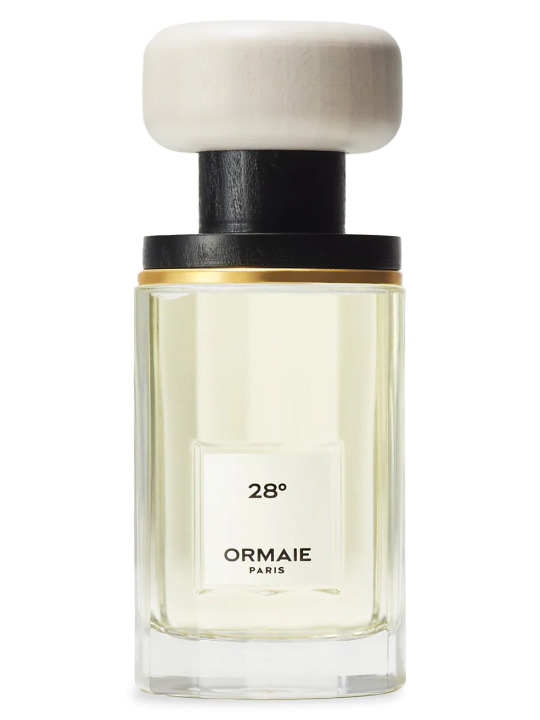
28° (eau de parfum) Ormaie
Floral
28 ° is a solar note reminiscent of a summer's walk. White flowers, monoi and shea butter, like a heatwave, the scent of holidays.
Top notes: Lemon, Bergamot, Mandarin, Schinus molle Heart notes: Rose, Sambac jasmine, Tuberose, Orange blossom Base notes: Sandalwood, Vanilla, Everlasting flower
#ormaie#eau de parfum#floral#lemon#bergamot#mandarin#schinus molle#rose#sambac jasmine#tuberose#orange blossom#sandalwood#vanilla#everlasting flower
2 notes
·
View notes
Text




#california pepper tree#schinus molle#pepper berries#flowering tree#microflora#branches against the sky#encino
4 notes
·
View notes
Text
Natural Healing -- Pirúl
Natural Healing — Pirúl
Photo credit: Georges Jansoone Pirúl (Schinus molle) is also known as pirú, perú, Falso Pimentero, gualeguay, Árbol Del Perú, Peruvian Peppertree, and in Nahuatl, it is Pelonquáhuitl. As you may have guessed, it is native to the Peruvian Andes. The botanical name molle comes from mulli, which is the Quechua word for tree. The indigenous put a high value on the pirúl because of its many uses.…

View On WordPress
#Árbol Del Perú#Falso Pimentero#gualeguay#herbal remedies in Mexico#mexican herbal remedies#Pelonquáhuitl#perú#pirú#Pirúl#Schinus molle#traditional herbal remedies
0 notes
Photo



Schinus molle, Anacardiaceae
When I first saw this small tree while on holiday in Lanzarote I had a feeling I had seen it before, but I only remembered what it was when I came across a few female plants bearing clusters of small, bright pink fruits. Not all trees were laden with them though, as the pepper tree, also known as Peruvian and Californian pepper tree, is a dioecious species with separate sexes on distinct individuals.
Native to arid and desertic areas of the Andean region spanning from Peru to Argentina, this compact, evergreen tree is well adapted to withstand prolonged drought and to benefit from winter rains, factors which made it very successful as an ornamental plant in the Canary Islands and many other parts of the world, like the Mediterranean, Africa and Australia, where it is often naturalised if not invasive. Although it is unrelated to the real pepper plant (Piper nigrum) the small drupes it produces following tiny white, star-shaped flowers, smell and taste very similar and are the source of what we know as pink peppercorn. I collected a few and checked their germination rate in this period using the wet towel and sealed plastic bag method: two out of six germinated readily within a week, but I realised that it is probably a good idea to take the time to completely remove the dry pink skin from the woody seed, as the two seedlings were covered in mould. I will try again later on this spring and will probably lightly sand them to remove the skin and thin out the seed coat to somewhat mimic avian seed dispersal, which is what generally improves germination of this plant.

When the tree is pruned, the bark exudes a white resinous gum which has been traditionally used to treat digestive issues, whereas the aromatic oils contained in most parts of the plant have antiseptic, antibacterial and insecticide properties. Although the dried fruits are a common food item, care should be taken as they can cause allergic reactions in individuals sensitive to other Anacardiaceae like cashews (Anacardium occidentale) and pistachio nuts (Pistacia vera).
#schinus molle#pepper tree#peruvian pepper tree#californian pepper tree#pink peppercorn#anacardiaceae#plant identification#plant photography#botany#plants#plantblr#ornamental plants#horticulture#gardeners on tumblr#edible seeds#spices#lanzarote#canary islands
99 notes
·
View notes